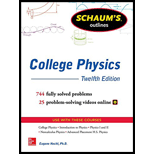
Concept explainers
An electron is accelerated from rest through a potential difference of 800 V. It then moves perpendicularly to a magnetic field of 30 G. Find the radius of its orbit and its orbital frequency.
The radius and orbital frequency of the electronthat is accelerated from rest through a potential difference of
Answer to Problem 35SP
Solution:
Explanation of Solution
Given data:
The electric potential difference is
The magnitude of the magnetic field acting on the electron is
Formula used:
The radius of a circular path of a charged particle moving along in a magnetic field is given as
Here,
The velocity of a charged particle moving due an electric potential difference is given as
Here,
The expression for orbital frequency of an object is given as
Here,
Explanation:
Consider the expression for radius of the circular path of an electron:
Here,
Consider the expression for the velocity of an electronmoving due to an electric potential difference:
From equation (1) and (2)
Keep in mind that
Substitute
Consider the expression for the velocity of an electron moving due to an electric potential difference:
Substitute
Consider the expression for the orbital frequency of the electron:
Here,
Substitute
Conclusion:
Therefore, the radius and the orbital frequency of the electron orbit are
Want to see more full solutions like this?
Chapter 30 Solutions
Schaum's Outline of College Physics, Twelfth Edition (Schaum's Outlines)
- 11. A small charged plastic ball is vertically above another charged small ball in a frictionless test tube as shown in the figure. The balls are in equilibrium at a distance d= 2.0 cm apart. If the charge on one ball is tripled, find the new equilibrium distance between the balls in cm and report it to the proper number of significant figures.arrow_forward12. The electric field at a point 1.3 cm from a small object points toward the object with a strength of 180,000 N/C. Find the object's charge q, in nC to the proper number of significant figures. k = 1/4πε0 = 8.99 × 10^9 N ∙ m^2/C^2arrow_forward14. When the potential difference between the plates of an ideal air-filled parallel plate capacitor is 35 V, the electric field between the plates has a strength of 670 V/m. If the plate area is 4.0 × 10^-2 m^2, what is the capacitance of this capacitor in pF? (ε0 = 8.85 × 10^-12 C^2/N ∙ m^2)arrow_forward
- 10. A small styrofoam ball of mass 0.500 g is placed in an electric field of 1140 N/C pointing downward. What excess charge must be placed on the ball for it to remain suspended in the field? Report your answer in micro-Coulombs to three significant figures.arrow_forward2arrow_forwardplease solve and answer the question correctly. Thank you!!arrow_forward
- Please solve and answer the question correctly. Thank you!! (Hint in second photo)arrow_forwardplease solve and answer the question correctly. Thank you!!arrow_forwardAssuming the normal angle for stairs in a house, 37.0˚ with the horizontal, what is Kevin’s acceleration down the stairs? The sled is always touching at least one stair so you can treat it the same as a ramp. The coefficient of kinetic friction between the sled and the carpeted stairs is 0.708.arrow_forward
 Modern PhysicsPhysicsISBN:9781111794378Author:Raymond A. Serway, Clement J. Moses, Curt A. MoyerPublisher:Cengage Learning
Modern PhysicsPhysicsISBN:9781111794378Author:Raymond A. Serway, Clement J. Moses, Curt A. MoyerPublisher:Cengage Learning Principles of Physics: A Calculus-Based TextPhysicsISBN:9781133104261Author:Raymond A. Serway, John W. JewettPublisher:Cengage Learning
Principles of Physics: A Calculus-Based TextPhysicsISBN:9781133104261Author:Raymond A. Serway, John W. JewettPublisher:Cengage Learning
 Physics for Scientists and Engineers with Modern ...PhysicsISBN:9781337553292Author:Raymond A. Serway, John W. JewettPublisher:Cengage Learning
Physics for Scientists and Engineers with Modern ...PhysicsISBN:9781337553292Author:Raymond A. Serway, John W. JewettPublisher:Cengage Learning Physics for Scientists and Engineers: Foundations...PhysicsISBN:9781133939146Author:Katz, Debora M.Publisher:Cengage Learning
Physics for Scientists and Engineers: Foundations...PhysicsISBN:9781133939146Author:Katz, Debora M.Publisher:Cengage Learning Glencoe Physics: Principles and Problems, Student...PhysicsISBN:9780078807213Author:Paul W. ZitzewitzPublisher:Glencoe/McGraw-Hill
Glencoe Physics: Principles and Problems, Student...PhysicsISBN:9780078807213Author:Paul W. ZitzewitzPublisher:Glencoe/McGraw-Hill





